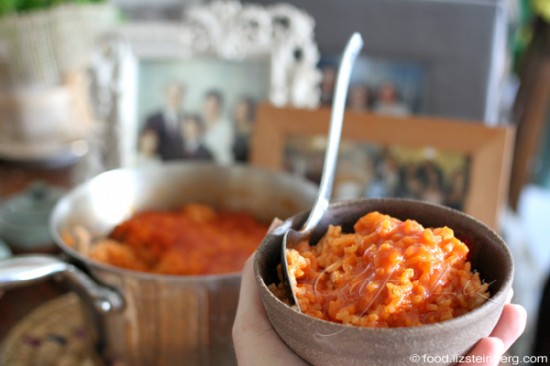
Grandma’s rice is the only dish I remember my Grandma Bea ever making. She wasn’t cooking much by the time I was born, and as it was, she never learned to make the labor-intensive burekas, bulemas and boyos of her mother’s generation. That wasn’t her era. While her aunts gathered to spend their days making filo dough together, she went to college despite her father’s wishes and headed off to work as a school secretary. She wasn’t made to be a housewife.
But she fed us her signature dish without fail, preparing a pot of tangy, salty, soft rice every time the grandchildren came over. She usually burned the bottom.
It was a simple concoction — rice cooked in tomato paste and chicken broth. A version of Spanish rice, my mom called it, though I never saw anything like it in Spain. I would hunt for the gooey lumps of undissolved tomato, while the adults would vie for the crunchy burnt layer stuck to the pot.
Grandma Bea wasn’t the original grandmother behind the rice — before her was her mother Rose, who made it for my mother. And Rose likely learned the dish from her mother in Constantinople (now Istanbul — grandma loved to sing that song, and I’ve heard it more times than you can imagine). My mother made it too, but it wasn’t the same, probably because she couldn’t bring herself to use the same generous helping of salt.
But that was then. Grandma slowly stopped cooking altogether, I moved away, and there were more exotic dishes to try. I hadn’t had grandma’s rice in more than a decade.
And then on June 5, suddenly, unexpectedly, she passed away.
Sure, she was 87, and she’d been battling cancer for the better part of a decade. But she was lively and vivacious, attending shows with her friends and bringing her Tupperware to the 5 p.m. happy-hour dinner special. She loved eating, especially dessert, and she wanted you to eat an extra-big slice of cake. She went out, she drove, she lived independently. She was savvy and assertive. Shopping was a game, and she was a champion athlete, proudly presenting us with her spoils. (“But it looks great on you! It was $100 at Neiman Marcus and I got it for $10!”) She showered us with gifts, whether we wanted them or not. (“What do you mean you don’t want it? It’s Waterford and I found it on clearance!”) She adopted new technologies, learning to use a computer and signing her e-mails “Thoroughly Modern Grandma.”
She defied statistics year after year, and we thought she would live forever. She seemed to know otherwise. In her house, she’d left behind a refrigerator full of cookies. As if she had been expecting us.
Back from the funeral, I thought about her rice. When my cousins and I were children, it had played a central role in our lives. As adults, she’d taught us all how to make it; her rice pot was one of the top items on my cousins’ inheritance request list. Yet no one seemed to be able to find the precise recipe.
But it wasn’t hard, was it? I had vague memories of a can of tomato paste dropped into sizzling oil. Lots of tomato paste. I think I recalled the size of the can …
And lo and behold, it came out just the way I remembered it. I even burned the bottom.

(A family photo taken at the time of Bea’s middle school graduation, with her parents Rose and Jack, and her little sister Sally. At right, just a few years later, Rose, Bea, my mother and me. I can’t say I remember that photo being taken.)
The secret to proper grandma’s rice is that it contains more tomato paste and salt than you’d consider reasonable, and more liquid than you’d usually use while cooking rice. All that water makes the tomato paste float, leaving your rice with a glossy orange coating on top by the time it’s cooked — my favorite part. The original recipe used two cups of rice, a can of chicken broth and an equal volume of water. If you substitute the broth back in, use unsalted broth or adjust the quantity of salt accordingly.
For two cups of rice:
- 100 grams (4 oz) tomato paste
- 2 tablespoons oil
- 1 cup rice
- 2 cups water
- 1.5 teaspoons salt
Cook time: 20 minutes.
(Note: A 2.5-liter pot is fine, but if you double the recipe, you’ll need a larger pot, say, 6 liters. This isn’t as obvious a statement as it sounds. The surface area of the pot matters: If the rice is too deep, it will be overly soft on top and drier on the bottom, and the bottom will burn more than you want it to.)
Heat the oil in a pot and add the tomato paste. Stir the tomato paste in the oil and let it cook for a few minutes, until the oil is orange and the tomato paste starts browning on the bottom of the pot. Stir in the salt.
Add the rice and water, and put a lid on the pot. Bring to a boil and then let simmer on a very low flame for about 15 minutes, or until all the liquid is absorbed. It will take a bit longer than a usual rice recipe, because it contains more liquid.
When the rice is done, it will have a glossy, soft layer of tomato paste on top.




